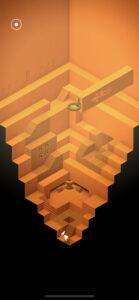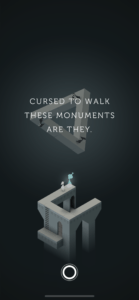Monument Valley was created by Ustwo Games and intended for a broad audience given the simple mechanics and low difficulty level and accessibility on iOS, the platform I used.
Monument Valley is a work of art and ambiance as well as a puzzle game. The puzzle aspects come mainly from becoming accustomed to the optical illusions within the impossible M.C.Escher-esque architecture, and discovering how pieces can move. The mechanics of the game are extremely simple for the iPhone version.
What makes it a good
These puzzles in MV fulfill mostly fulfill the criteria for a good puzzle in our readings for this week. The designers exemplify fairness; the puzzles are easy to figure out with everything you’d need to solve the puzzle on one screen and a point-and-touch interface to move your character(s) (Ida and sometimes her friend a totem pole). The mechanics of the puzzle continue the narrative, as she moves through the monuments to get further on her quest. Unlocking the puzzles leads to the unfolding of new levels and amplifies the theme of impossible architecture on her mysterious quest further. This level was particularly clean, with simple movements and a darkening theme as she makes her descent.


What I didn’t like
Since the puzzles themselves are extremely straightforward, with limited variations in the type of movements available, I didn’t have any AHA moments. For example, with the point and click (touch) mechanism, I’d often click where I wanted to go first to see it it would find a path for me, eliminating some of the puzzle aspect of seeing through the optical illusion for paths. If the difficulty is raised in future levels, I may have this, but I do not see the game as a challenge personally, detracting some fromthe fun. I’m pretty ADHD and got bored quite a few times getting through the levels, dealing with her slow walking pace and the repetitive mechanics. The darker level image shows a really long walk from the entry to the first button with a single click. The game puts some in a trance, with the soothing background and sounds triggered by gameplay, but it was a bit too slow for my attention span.
The element of the narrative is left vague and anonymous, leaving the purpose of the silent princess, Ida up for interpretation. Also, I see the intention of the designers to leave the narrative this way for users to superimpose their own ideas, but I do wish that there was some defined story or motivation to help the user find reason in helping the princess on her quest. I’m not really sure what her quest is still after playing for multiple hours, so I don’t feel much motivation to continue on her journey.





